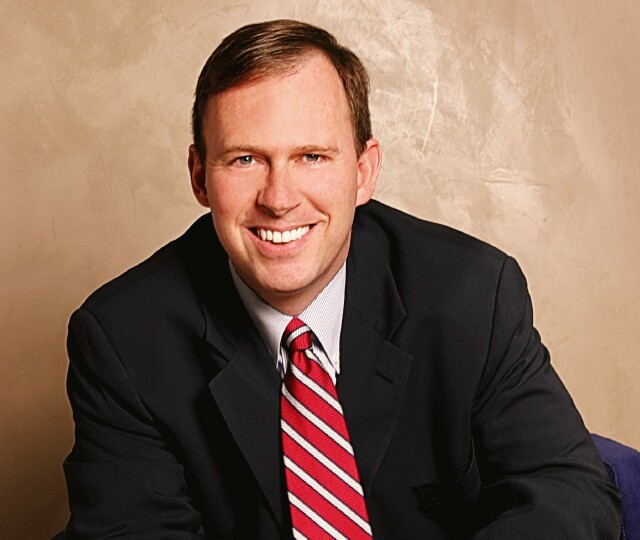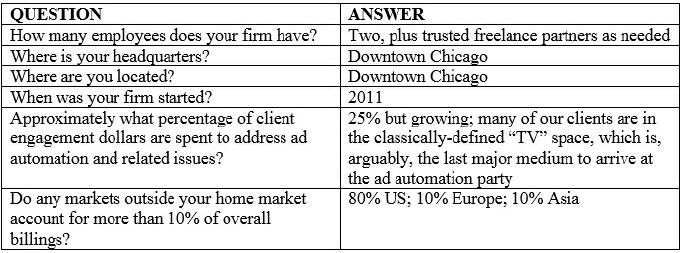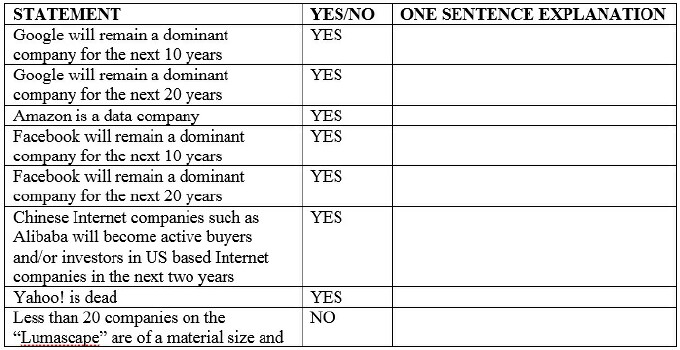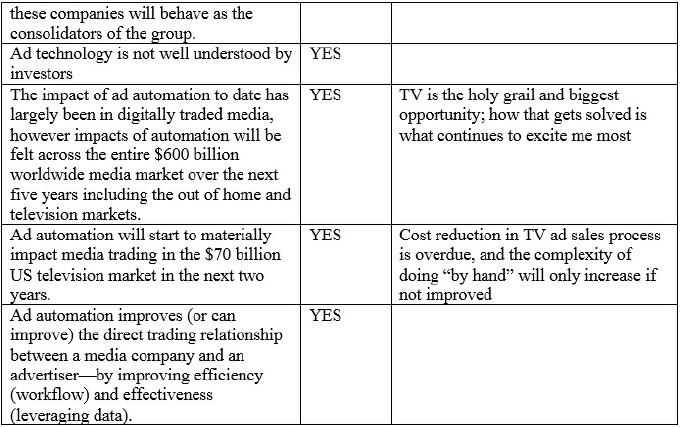Tim Hanlon of The Vertere Group: The Ad Automation & Programmatic Confidantes

In a series of conversations with the leading confidantes and consultants in the ad automation and programmatic area, Jay Sears, Senior Vice President of Rubicon Project, discusses trends and issues of the day impacting advertisers and media owners. In this interview, he talks with Tim Hanlon, Founder and CEO of The Vertere Group.
Prior to starting Vertere, Hanlon founded Velociter, the partnership and strategic investment arm of IPG’s Mediabrands, and before that served as Executive Vice President/Media Director of Publicis Groupe’s VivaKi Ventures. When he was Senior Vice President/Director, Emerging Contacts for Starcom MediaVest, he oversaw its TV 2.0 Practice, centered on evolutionary television platforms such as interactive/enhanced television, on-demand video, digital video recording, interactive program guide navigation, addressable advertising, and digital broadcasting/multi-casting.
JAY SEARS: What do you read and listen to, to keep up with politics, art and culture?
TIM HANLON: An eclectic cadre of digital sources: Jason Hirschhorn’s Media and Sports Redef newsletters; Bob Lefsetz’s Lefsetz Letter; Wait But Why; The Atlantic’s “CityLab;” Howard Stern; multiple Twitter feeds (including @HistoryInPics, @Super70sSports, @SportsPaperInfo, @BoredElonMusk, @AwfulAnnouncing, @EmptySeatsGalore and @EliteDaily); multiple podcasts (including Gilbert Gottfried’s Amazing Colossal Podcast, WTF with Marc Maron, Whistlestop with John Dickerson and SI Media Podcast with Richard Deitsch) . . . and non-fiction books! (The latest: “The Skies Belong to Us: Love and Terror in the Golden Age of Hijacking,” by Brendan Koerner; “The Divide: American Injustice in the Age of the Wealth Gap,” by Matt Taibbi, and “Disrupted: My Misadventure in the Startup Bubble,” by Dan Lyons.)
SEARS: What do you read to keep up with friends?
HANLON: Facebook, Instagram, Snapchat, LinkedIn, personal emails – and good old-fashioned holiday cards!
SEARS: What do you read to keep up with the advertising technology industry?
HANLON: An eclectic cadre of digital sources, especially those geared towards video and audio sectors, including Mediapost/OMMA (and virtually all of their 10,000 offshoot newsletters), Multichannel News, Broadcasting & Cable, Fierce Cable, Nick Quah’s “Hot Pod” newsletter, Adexchanger, Mark Ramsey Media, Will Richmond’s VideoNuze, Ken Doctor and the entire Neiman Lab, Tracy Swedlow’s “TV of Tomorrow,” Digiday, Ad Age, Rich Greenfield’s BTIG research, Brian Wieser’s Pivotal research and Twitter feeds @davezatz, @jank0 and @pkafka.
SEARS: What’s your favorite commercial of all time?
HANLON: Carvel Ice Cream commercials from late 70s/early 80s. (If you are from the New York City area these need no explanation.)
SEARS: With regards to advertising automation, what are the three biggest trends you expect to impact companies in 2016?
HANLON:
- Publishers pushing back on intermediaries to reclaim fuller oversight and ownership of ad inventory availabilities and monetization (happening now).
- TV sellers (and buyers) will start to experiment more aggressively with more digital-like automated technologies and processes (late 2016/early 2017).
- Political ad spending post-mortems will convince local media ad sellers that data-driven targeting is real and now expected in all forms of digital/electronic media – including/especially TV!
SEARS: With regards to advertising automation, what are the three most overblown topics that you wish would just go away?
HANLON:
- Arrogance
- Ignorance
- Fear
SEARS: Describe your firm and then tell us the three most common issues you help clients on with respect to advertising automation and programmatic trading.
HANLON: The Vertere Group is a strategic consulting and investment advisory at the intersections of media, marketing, advertising and technology -- especially in the area of advanced TV and video. Generally, we tend to be of most help to three types of entities: 1) legacy media content/distribution firms that struggle with emerging trends and technological innovations emanating from outside their traditional walls; 2) early-stage/entrepreneurial tech firms that, conversely, clamor for attention from and validation by established media companies, marketers and agencies, and 3) investors, analysts and management consultants who seek insight into the trends and inevitabilities of this fast-changing space.
SEARS: Tell us more about your firm:
HANLON:

SEARS: Tell us the most common issues you help clients on regarding automation.
HANLON:
- Implications to rate integrity (TV ad sellers)
- Uncertainty of valuing/negotiating rates via non-Nielsen currency (TV ad sellers)
- Deciphering myriad number of tech vendors, overlapping functional capabilities and conflicting agendas (TV ad buyers and sellers)
SEARS: The majority of ad technology companies have struggled (relatively small, unprofitable or both). Of the poor performers, what are the commonalities between them that have contributed to this weakness?
HANLON: A surprising amount of troubled firms I have seen over the years followed a surprising common path: What may have started out as a compelling problem-solving ad technology or media data solution, somehow pivoted into some form of media ad sales arbitrage ad network play in an effort to bank the “easy money” from digital media buyers in the short term, and show fast growth to impatient venture investors. Of course, as the ad tech landscape careens towards point solution consolidation, and as the entire industry now struggles to become more direct and transparent in operational practices, opaque intermediaries (like ad networks!) will be harder-pressed to prove value to ad buyers and sellers -- and many will be squeezed out of the food chain entirely. I see a ton of tech-turned-media-sales companies now trying to quickly revert back to more tech/SaaS solution approaches, but it may be too late for a whole bunch of them at this point.
I also think you have a lot of pent-up venture money behind a number of firms that missed the window to go public that are “exit-stuck” for their investors (e.g., Mode Media), as well as a bunch of firms that actually did IPO under the media sales model and are feverishly trying to pivot back to their tech roots -- more painfully under public investor scrutiny. Fun times!
SEARS: A smaller handful of ad technology companies has achieved scale and performed better than the rest. What are the commonalities between them that have contributed to this relative strength?
HANLON:Luck and timing!
SEARS: Do we live in a “tale of two cities” where Google and Facebook win almost everything, advertisers are dictated to and other media companies fight for the scraps?
HANLON:Google and Facebook have an increasingly unassailable advantage in first-party digital consumer data that make it ridiculously difficult for anyone outside their hegemonies to exert influence over data-targeted media. The only exception to that rule (at least for now) is television, which is still very much a closed system relative to digital. As TV inevitably moves towards ubiquitous IP delivery, the application of data for ad targeting will radically increase importance, just like in digital. It remains to be seen if either Google or Facebook can crack the data tech code for television -- it’s by no means a slam dunk for them, especially if the TV industry has anything to say about it.
SEARS: Please answer the following statements yes or no.
HANLON:


SEARS: If you could go to the airport right now with friends or family and fly anywhere in the world for vacation, who would you take and where would you go?
HANLON: Wife and two daughters to Italy to bike and backpack across the countryside.
SEARS: If you could create an endowment to fund any existing non-profit you designated, what lucky non-profit organization would that be?
HANLON: Canine Therapy Corps, Chicago Illinois, which empowers and motivates individuals to improve their physical and psychological health/well-being by harnessing the bond between humans and animals -- by providing goal-directed, interactive animal-assisted therapy services (free of charge) using volunteers and certified therapy dogs.
SEARS: What is your favorite restaurant in the world?
HANLON: The Chit Chat Diner, Hackensack, New Jersey – and diners in New Jersey in general. Man’s most creative invention!
SEARS: Thanks, Tim!
Click the social buttons above or below to share this content with your friends and colleagues.
The opinions and points of view expressed in this article are exclusively the views of the author and/or subject(s) and do not necessarily represent the views of MediaVillage.com/MyersBizNet, Inc. management or associated bloggers.


